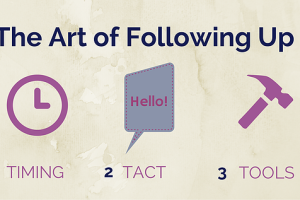It would be difficult to overstate the importance of mastering “the art of the close.”
You can get every other aspect of your sales process perfect, but if you fumble the closing stage, all that effort is wasted. You lose a client. They miss out on your solution. How can we do better at this?
There may not be a one-size-fits all strategy for sealing the deal with prospective customers, but that doesn’t mean there aren’t a few professional tricks out there.
Don’t be afraid to ask for a customer’s business.
Probably the first thing we have to do is get over our fear of being proactive.
We need to realize that there is nothing inherently manipulative or underhanded about asking for a prospective customer’s business. The polite, friendly part of us appropriately wants to avoid irritating or offending prospective customers, but we can’t afford to let ourselves be hypersensitive.
Once we are convinced we have laid a perfectly viable solution on the table, we must never fail to ask for a prospect’s buy-in simply because we fear being rejected or having a customer cry foul on our efforts.
Remember: If the prospect has a problem that you and your solution can solve – it is NOT manipulation. They need you. Here’s a few questions you can use to help coax a prospect off the fence. Asking such things as, “What obstacles remain before we can get started?” or “What kind of a time-line are you looking at to get started on this?” prompt a customer to consider the next step regarding your proposal.
They keep the focus on your solution to their real problems, not on the proximity of a sale for your company.
Mind your attitude and body language.
This may seem like common sense, but it’s alarming how many salespeople lose out on business simply because their behavior is distracting or off-putting to their customers.
If your prospective clients sense that you’re “on edge,” whether antsy to make the sale or else walking on eggshells to avoid losing the sale, they may grow suspicious wondering whether you’re hiding something at their expense. It pays to project an air of confidence—though not arrogance—as you attempt to seal a deal.
Advice…
-
Speak clearly and articulately.
-
Smile and maintain appropriate eye contact.
-
Use humor and storytelling where possible.
-
Keep your side of the whole conversation positive and upbeat.
Such things set customers at ease because they indicate your confidence in yourself and in the product you represent. They help mitigate the negative, often adversarial presumptions about salespeople that buyers may bring with them from previous purchase experiences.
Generate a sense of urgency about the project.
When you’re dealing with an eager customer on a tight deadline, you can rest assured that urgency will be an organic part of the process. Your ability to provide a viable solution by the customer’s deadline will all but decide whether you net the deal. There are plenty of cases, however, where you’re the one on the tight deadline while your prospect is giving no indication of making a decision anytime soon.
In these situations, if you want to close the sale you’re going to have to cultivate urgency yourself—but delicately, without attempting to force a solution where a problem does not exist.
An approach I take to assess and amplify a potential buyer’s sense of urgency regarding your offering is…
1) Study your previous deals to determine the average length of time it takes to close on your sales.
2) Based upon the results of this analysis, you can arrive at a non-arbitrary time frame for future deals, and you can even toss this information into your closing efforts.
Let’s say you’ve determined that several previous customers needed to move on implementing your solution within four to six months of hearing your first pitch. It would be appropriate to use that information to follow-up with your prospect, indicating your desire to avoid disadvantageous delays.
You might say something like, “Based upon our previous experience with clients in your situation, we find that most customers need to begin implementation within six months. Would you say that fits your scenario, too?”
Such a follow-up is not goading the customer to give you a decision prematurely; it indicates genuine interest in accurately understanding your potential buyer’s needs. And, based upon the response you receive, you can decide whether to gear up your efforts or redirect them toward other leads.
Once you’ve gotten an indication of assent from the customer, be sure you don’t mess the deal up by dallying around with the paperwork. You don’t want to rush your customer, of course, but neither do you want to let your lack of preparation or diligence create an opportunity for the customer’s forward momentum to slow.
Remember that objections are opportunities.
Some salespeople fold under the pressure of customer objections. When a prospect begins calling certain product features into question or expresses dissatisfaction with some element of their solution package, these individuals falter and reveal that they really weren’t anticipating any customer concerns.
Two things are likely to happen at this point.
First, the salesperson’s hesitation will introduce a real element of doubt into the customer’s mind.
Second, the customer’s push-back may lead the salesperson to conclude he has already failed.
Although confident, well-prepared salespeople know better. They push forward, even when some difficult issues still need to be dealt with before signing a deal.
An objection means the buyer cares enough about you and the sale to want to explore it with you. They’re telling you about a concern they have, in the hopes you’ll help them resolve it. It’s our job as sellers to partner with our potential customers at this point, recognizing their objections as signs of engagement, building trust by honestly dealing with their concerns as best we can.
Perhaps there is a feature we neglected to explain clearly. Perhaps there is wiggle room in the contract to accommodate certain special needs. Providing adequate, confident responses to customer objections is a strong closing technique. But we should also recognize that we’re not out to sell people what they don’t need, and if we cannot adequately address the objections, it’s probably because there’s just not a good buyer-seller fit, and we must not take that as a sign of failure.
And for bonus points, if it comes to it… You get even more credit if you back out gracefully when your offer isn’t right. You’ll increase the odds of getting the next sale, and the one after that. So even if you’re unable to close this sale, you can still view it as a “pre-close” on future opportunities with the customer. The better you understand what your customers’ objections reveal about their needs, the better your chances of netting the deal with a new solution down the road.
Send your customers home with something to try.
There is a tried-and-true sales technique that professionals shamelessly call “the puppy dog close.”
It’s a familiar set-up: a pet store employee graciously allows parents to take the puppy their children are begging for home for a day or two with no obligations to buy. Once the children fall in love with the little guy, the sale is all but in the bag.
Who’s going to return the puppy once there’s an emotional attachment to it? Car dealers use the same technique, inviting prospects to take a vehicle home for a personalized test-drive on their own daily commutes. There’s no obligation to buy, but the dealer knows that those customers will have to come back soon, and they know that once drivers have experienced the joy of ownership, they’re much more likely to close on the deal.
Admittedly, this technique sometimes gets a bad rap for being manipulative, but we’re not talking about trying to send a puppy home with a family who clearly doesn’t need another pet. We’re talking about conclusively demonstrating that the product we’re offering actually addresses a customer’s genuine needs.
SaaS merchants are in a unique position to take advantage of this closing technique. Offering trial versions of software is nothing new, but if done with finesse, offering a meaningful opportunity to test-drive your whole-package solution—in tandem with other closing techniques already discussed—just might be the key to winning that right-fit customer into your user base.
Not all trials yield equal results. Most SaaS solutions offer time-bound trials, allowing prospective users full access to all features for a limited period of time, after which they must purchase a subscription to continue making use of the application. This is great for generating that elusive sense of urgency that helps close sales, but it only works if the time window for the trial happens to coincide with the best time frame for your prospective customer to actually tinker around with the features and discover real value worth paying for.
Another option is to allow customers to have uninhibited access to a version of the application that limits most of the more attractive features to paid subscribers. This has the advantage of giving a prospect plenty of time to become hooked on the basic product features and to begin adapting the solution to their immediate business needs.
There’s no guarantee the customer will ultimately upgrade to the fully-featured version, of course, so perhaps a combination of the two approaches is appropriate.
In all honesty, I’m not as much of a fan of this approach because at times you tend to tease the customer with just enough of features to be let down. You then have to fight the uphill battle of convincing the prospect that the ‘missing’ features from the free trial access are worthy of a premium price and the time it takes to evaluate them.
Consider making a limited-feature version available for free, but then follow up with prospects to offer time-bound access to the full product. Introduce limited-time upgrade discounts to generate urgency for an up-sell to an already-hooked user.
This certainly won’t be the last we talk about ‘deal closing’ but a final point…
Closing sales is about more than just a salesperson’s rhetoric and persuasive ability.
Although it is vitally important for us to create a sense of urgency in customers’ minds in order to monetize their buy-in, we must also work hard to craft wholesale marketing approaches that look toward the close of sales from the very beginning.
We do this by making our products singularly attractive, our prices reasonably accessible, and our promotional incentives irresistible. This combination of superior marketing strategy and individual closing techniques is what really makes the difference in securing long-term, profitable business relationships.








